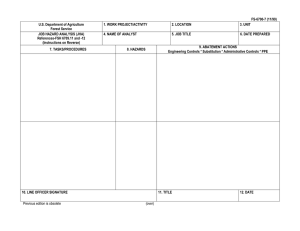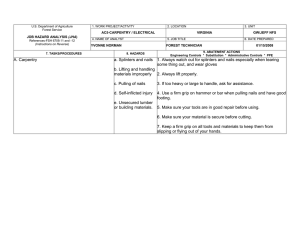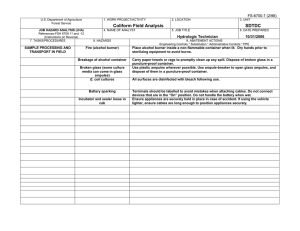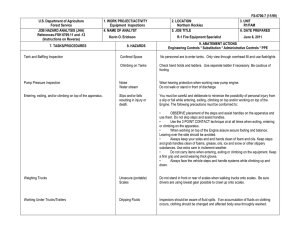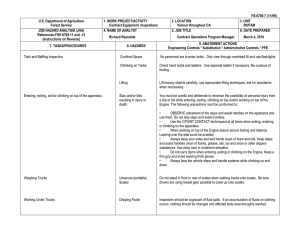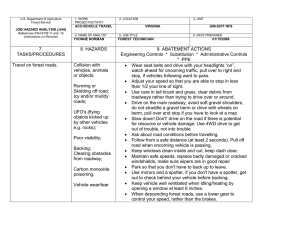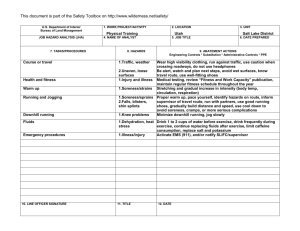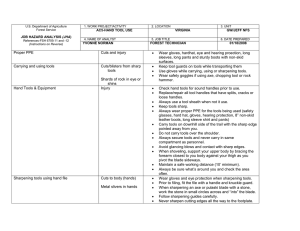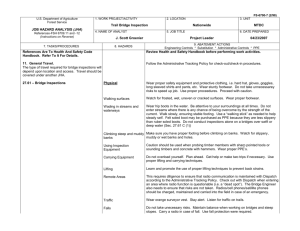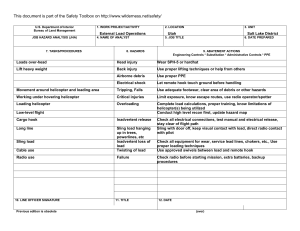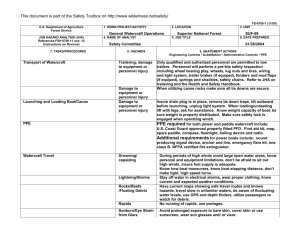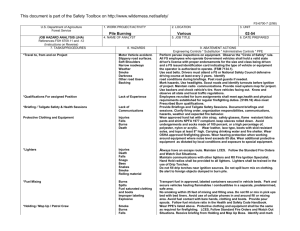AC5-WEATHER RELATED VIRGINIA GW/JEFF NFS (JHA
advertisement
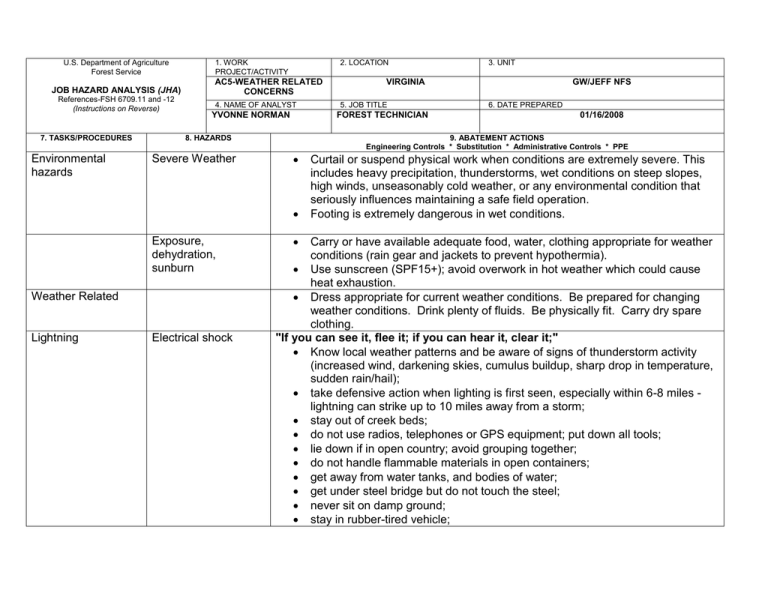
U.S. Department of Agriculture Forest Service JOB HAZARD ANALYSIS (JHA) References-FSH 6709.11 and -12 (Instructions on Reverse) 7. TASKS/PROCEDURES Environmental hazards 1. WORK PROJECT/ACTIVITY 2. LOCATION AC5-WEATHER RELATED CONCERNS 4. NAME OF ANALYST YVONNE NORMAN Severe Weather Weather Related Lightning Electrical shock 5. JOB TITLE GW/JEFF NFS 6. DATE PREPARED 01/16/2008 9. ABATEMENT ACTIONS Engineering Controls * Substitution * Administrative Controls * PPE Exposure, dehydration, sunburn VIRGINIA FOREST TECHNICIAN 8. HAZARDS 3. UNIT Curtail or suspend physical work when conditions are extremely severe. This includes heavy precipitation, thunderstorms, wet conditions on steep slopes, high winds, unseasonably cold weather, or any environmental condition that seriously influences maintaining a safe field operation. Footing is extremely dangerous in wet conditions. Carry or have available adequate food, water, clothing appropriate for weather conditions (rain gear and jackets to prevent hypothermia). Use sunscreen (SPF15+); avoid overwork in hot weather which could cause heat exhaustion. Dress appropriate for current weather conditions. Be prepared for changing weather conditions. Drink plenty of fluids. Be physically fit. Carry dry spare clothing. "If you can see it, flee it; if you can hear it, clear it;" Know local weather patterns and be aware of signs of thunderstorm activity (increased wind, darkening skies, cumulus buildup, sharp drop in temperature, sudden rain/hail); take defensive action when lighting is first seen, especially within 6-8 miles lightning can strike up to 10 miles away from a storm; stay out of creek beds; do not use radios, telephones or GPS equipment; put down all tools; lie down if in open country; avoid grouping together; do not handle flammable materials in open containers; get away from water tanks, and bodies of water; get under steel bridge but do not touch the steel; never sit on damp ground; stay in rubber-tired vehicle; take shelter in building if available, or caves (without metal and not shallow), ditch or canyon; avoid high objects such as lone trees; crouch away from lone trees keeping a distance of twice the height of the tree away; keep away from fences, power and phone lines; avoid ridge, roof and hill tops; get away from animals; If you feel electrical tingle or hair standing on end, drop to ground immediately; Know CPR and first aid Hot weather Heat cramps, stroke and exhaustion Sunburn Heat Stress Hypothermia a. b. c. d. e. f. g. h. High wind Falling objects 10. LINE OFFICER SIGNATURE Know symptoms of each condition; drink plenty of water (I liter/hr) throughout the day whether thirsty or not; dress in layers; acclimate to hot weather gradually; work at moderate pace during hottest part of day; wear sun block (SPF15+) on exposed skin; wear sunglasses; wear hardhats Wear proper clothing for the weather conditions. Drink plenty of fluids. Be physically fit. If any of the following conditions occur get medical attention immediately. Painful muscle spasms Cool, moist, pale, flushed, or ashen skin Weakness, exhaustion A change in level of consciousness High body temperature Red, hot skin Rapid or weak pulse Rapid or shallow breathing Avoid working in old, defective timber stands or around any trees during periods of high winds due to snag hazard. Keep eyes open for overhead dangers (limbs); wear hardhat at all times; know daily forecast; leave wooded areas if limbs are knocked out of trees or if danger of falling limbs or trees is imminent 11. TITLE 12. DATE /s/ Henry Hickerson DFS 1/23/08 JHA Instructions (References-FSH 6709.11 and .12) The JHA shall identify the location of the work project or activity, the name of employee(s) writing the JHA, the date(s) of development, and the name of the appropriate line officer approving it. The supervisor acknowledges that employees have read and understand the contents, have received the required training, and are qualified to perform the work project or activity. Blocks 1, 2, 3, 4, 5, and 6: Self-explanatory. Block 7: Identify all tasks and procedures associated with the work project or activity that have potential to cause injury or illness to personnel and damage to property or material. Include emergency evacuation procedures (EEP). Block 8: Identify all known or suspect hazards associated with each respective task/procedure listed in block 7. For example: a. Research past accidents/incidents b. Research the Health and Safety Code, FSH 6709.11 or other appropriate literature. c. Discuss the work project/activity with participants d. Observe the work project/activity Emergency Evacuation Instructions (Reference FSH 6709.11) Work supervisors and crew members are responsible for developing and discussing field emergency evacuation procedures (EEP) and alternatives in the event a person(s) becomes seriously ill or injured at the worksite. Be prepared to provide the following information: a. Nature of the accident or injury (avoid using victim's name). b. Type of assistance needed, if any (ground, air, or water evacuation) c. Location of accident or injury, best access route into the worksite (road name/number), identifiable ground/air landmarks. d. Radio frequency(s). e. Contact person. f. Local hazards to ground vehicles or aviation. g. Weather conditions (wind speed & direction, visibility, temp). h. Topography. i. Number of person(s) to be transported j. Estimated weight of passengers for air/water evacuation. The items listed above serve only as guidelines for the development of emergency evacuation procedures. e. A combination of the above Block 9: Identify appropriate actions to reduce or eliminate the hazards identified in block 8. Abatement measures listed below are in the order of the preferred abatement method: a. Engineering Controls (the most desirable method of abatement). For example, ergonomically designed tools, equipment, and furniture. JHA and Emergency Evacuation Procedures Acknowledgment We, the undersigned work leader and crew members, acknowledge participation in the development of this JHA (as applicable) and accompanying emergency evacuation procedures. We have thoroughly discussed and understand the provisions of each of these documents: SIGNATURE b. Substitution. For example, switching to high flash point, non-toxic solvents. Work Leader c. Administrative Controls. For example, limiting exposure by reducing the work schedule; establishing appropriate procedures and practices. d. PPE (least desirable method of abatement). For example, using hearing protection when working with or close to portable machines (chain saws, rock drills portable water pumps) DATE SIGNATURE DATE e. A combination of the above. Block 10: The JHA must be reviewed and approved by a line officer. Attach a copy of the JHA as justification for purchase orders when procuring PPE. Blocks 11 and 12: Self-explanatory.
